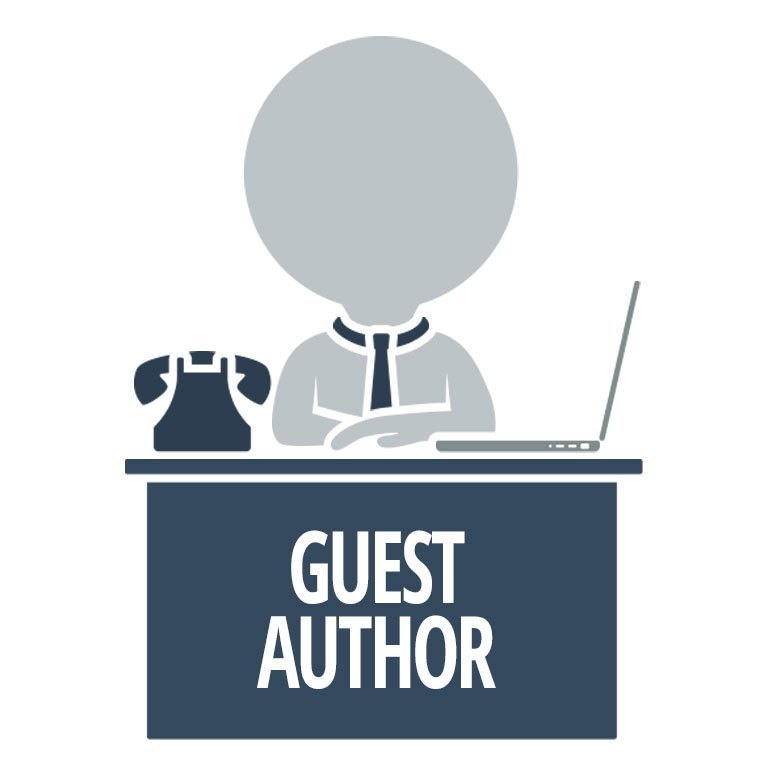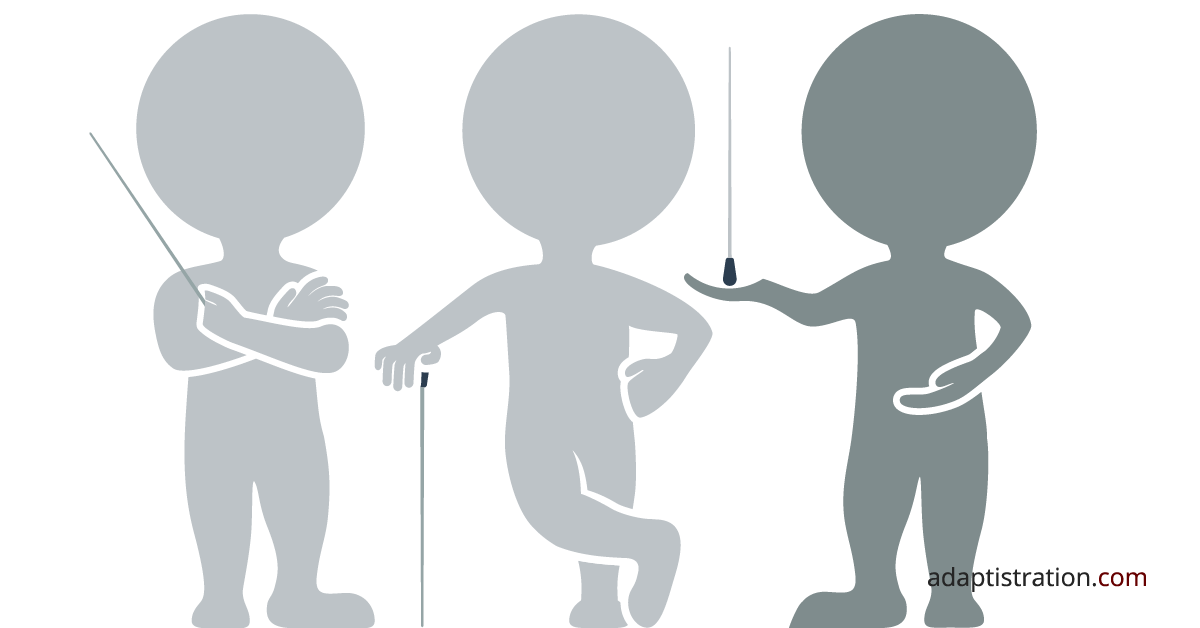
Last fall I delivered a lecture in Amsterdam about stage acoustics for orchestras, thinking it was a great opportunity to share what I’d learned over the years and looking forward to further study. A year later, I have no idea when I’ll be allowed to travel to hear the Concertgebouw again and the picture of an orchestra on a stage – any orchestra on any stage! – looks wildly different than anything I envisioned at the time.
Orchestras and the stages they inhabit have evolved steadily over time in a sequence of pushing together, pulling apart, and rearranging sections in pursuit of listening conditions that are comfortable and equitable on stage and provide balanced projection to the audience. With only a few exceptions – most notably a gulf in front of brass players to protect hearing – the dominant goal has been to move players in proximity to one another. Normally, a supportive stage acoustic environment for orchestra embodies four basic features:
- Clear and proximate line-of-sight (and therefore line-of-hearing) between players for players to hear sound directly from instruments across the orchestra to aid in timing and balance;
- Surfaces near the players, most often side and rear walls, to aid in hearing one’s self and the rest of one’s own instrumental section;
- More distant surfaces, often overhead, that blend the sound of the orchestra helping musicians balance their dynamics with other players and sections;
- Proximity between players within the same section, to foster both timing and balance.
Like just about everything else in 2020, however, these goals have been turned on their heads. And even with hope for a return to something approaching ”normal” in late 2021, there is a lot of music to be played between now and then.
Airborne transmission of COVID-19 necessitates that people maintain a safe physical distance from one another so any virus particles are either dispersed in the air to safe concentrations or drawn away through air ducts to be safely filtered away. Numerous studies show that heavier breathing pushes out more virus particles and the activity of orchestra musicians – whether the physical exertion of a string player or the forceful blowing of a brass player – ups the ante for potential transmission. Musicians can only play if the air on stage is safe for them to do so.
There are many open questions about how to most effectively safeguard the air on stage, and I will defer to those experts in airflow and sanitization speak to the necessary techniques. One recent study of Abravanel Hall in Salt Lake City, undertaken by professors from the University of Utah, suggested keeping stage side doors open to allow more space for air to leave the room, moving brass instruments near air inlets around the stage to extract air more quickly, and negatively-pressurizing the hall to draw air rapidly into return inlets. Other halls may benefit from different techniques to optimize airflow, but for the moment we can assume similar approaches are likely to become common. Nearly everyone agrees, however, that a minimum requirement is for significant space between and for as many players as possible to wear masks. A number of other excellent ongoing studies are exploring how much aerosol and droplet to expect in the air around different instruments but, while guidance is evolving, many ensembles have adopted 8ft. between string players and 10ft. around all wind instruments.
Once an orchestra adopts a strategy for making it their musicians safe, we return to artistry: how can the altered stage be most hospitable to music-making?
With a COVID-modified stage, what were once desirable features of a stage shift askew. The proximity between players is eliminated. Some of the surfaces nearest the players may be removed to improve airflow. The extra space between musicians also places a few musicians near walls (some of whom may not normally sit there) but many others out in space far away both from the sectional colleagues and any sound reflective surfaces. Overhead surfaces are likely still present, but the balance between the direct sound on stage, sound reflections off walls, and overhead sound reflections will not reflect “typical” on-stage conditions.
A rational instinct for any orchestra setting in under COVID conditions might be to use the stage enclosure to support the few musicians on stage with as many sound reflections as possible: Lower the ceiling! Retract all variable acoustics! As with many things involving dozens of sources of sound in a large room, however, the best approaches may run counter to initial instinct.
When players are all tightly packed on a supportive stage, they receive timing and balance information from the direct sound of their section, the direct sound of instruments outside their section, and sound reflections off wall and ceiling surfaces. A simple way of looking at the relative contributions comes from at each musician as an independent sound source within the orchestra (I’ve only drawn a few of the sonic paths so you can still see the musicians in the background!):
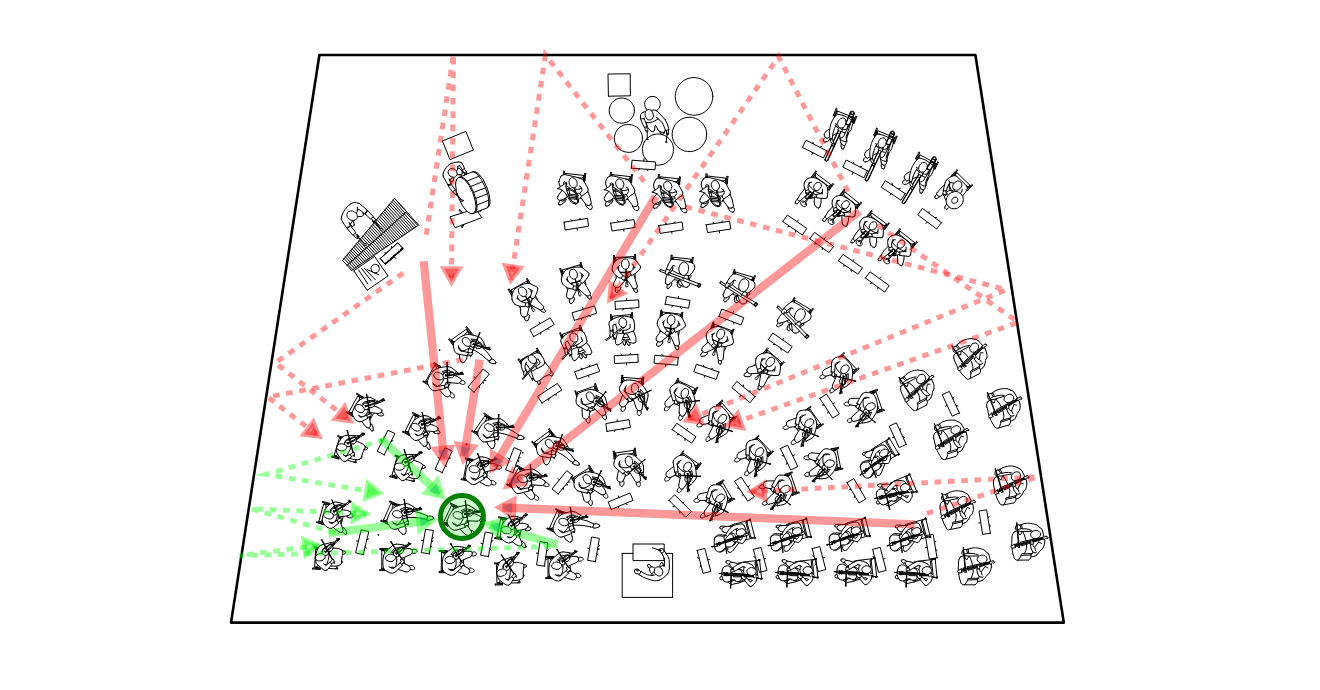
The individual player is subject to sound from dozens of paths around the stage; but we can group certain paths of sound together. The direct sound from one’s own section is critical to playing in unison and the direct sound from other sections is crucial for timing. The reflected sound can be beneficial when it blends with direct sound to help provide a sense of support and balance, but it can make listening very difficult when it overwhelms direct sound, especially from one’s own section. (Does this oversimplify things a bit? Of course! In each hall we look at detailed reflections patterns to help identify exact paths that are useful or detrimental, but the simplifications are useful for a broader discussion.)
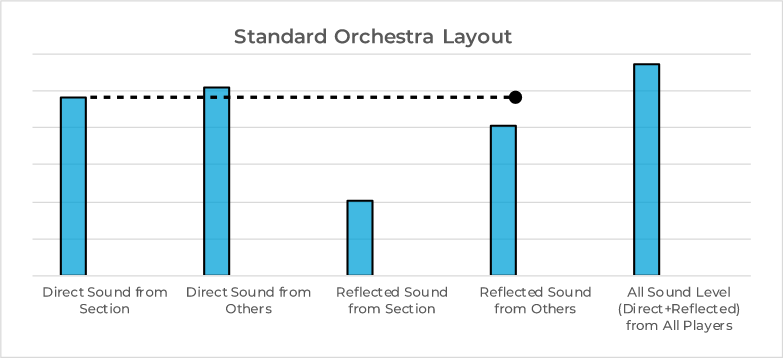
With a spaced orchestra, however, sections get smaller and stretch further apart. If the surfaces surrounding the orchestra – walls and ceiling – remain the same as before, the sound that a musician hears from their own section diminishes relative to the sound of the rest of the ensemble.
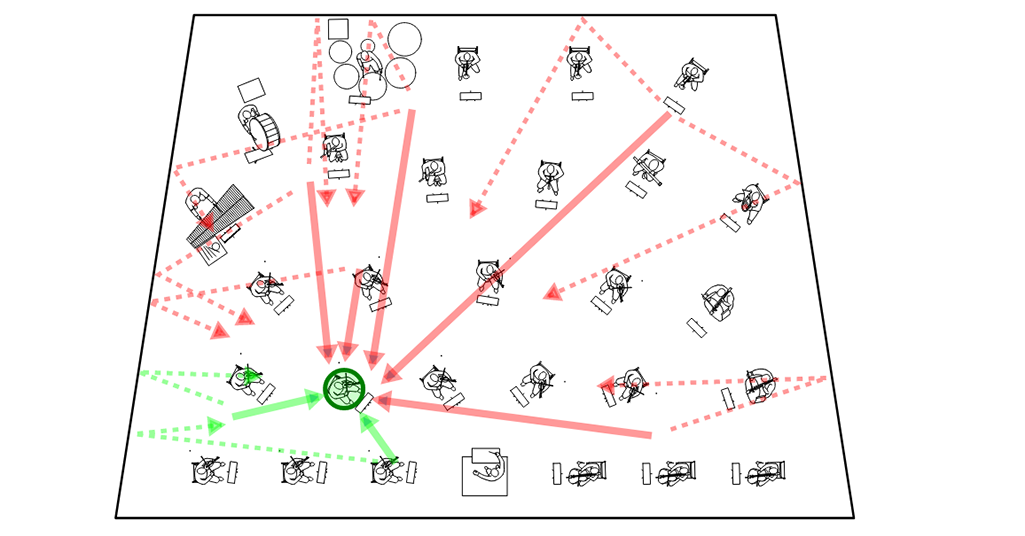
With fewer musicians on stage, the rest of the section is further away and populated by fewer players. A few louder individual instruments can begin to overwhelm the direct sound of the section especially when their reflected sound is taken into account. It is worth noting that this is equally true of wind or brass instruments, as well as string players.
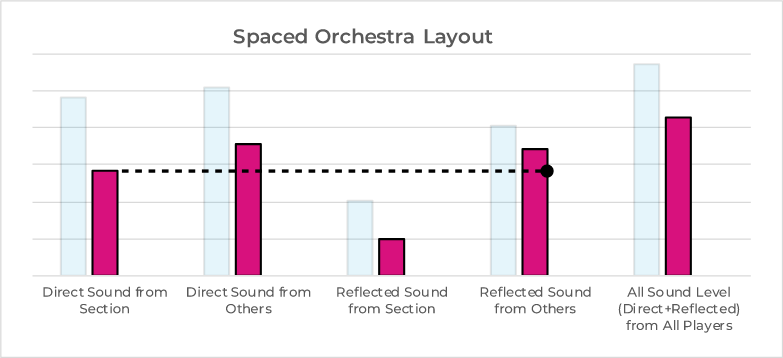
Counterintuitively, it becomes beneficial to “turn down” the loudness on stage by limiting some of the acoustic reflections that are desirable with a tighter ensemble.
This strategy first occurred to me over the summer when the church I attend began meeting outdoors. Much to my initial surprise, I could clearly hear the distinct voice of fellow congregants during singing in ways I’d never experienced either indoors or in more tightly packed outdoor settings (fortunately my church is populated by a number of skilled singers, so this was nice!). Some of the vocal blend that occurs indoors was missing, of course, but it was far easier to hear each individual allowing me to key in on specific voices. I was reminded that the idea of broad spacing in Robert Shaw chorales, which he posited allowed choristers to “… hear themselves and other people better than if they were huddled together with their shoulders hunched…”
This approach can succeed when musicians have a clear line-of-hearing to one another for the sake of timing and intonation, and when any surfaces around the stage provide some support for the sake of dynamic balance but not so much support that it overwhelms the sound of one’s own section.
Looking at the examples above, if we remove a significant component of the wall reflections but maintain the overhead reflections, we see a much better balance:

As we re-prioritize stage acoustics for the COVID era, we can focus listening conditions for orchestral musicians in slightly different ways:
- Emphasize direct sound between musicians as much as possible. If risers are available, use all of them, creating as much vertical separation between musicians as possible to maximize lines of hearing.
- Find ways to modestly reduce side and rear wall reflections. If stage doors (or gaps are left in orchestra shells) for the sake of airflow, embrace the reduction of wall area. If variable acoustic elements exist around the stage – especially on the upstage wall – deploy them (this will also helpful for microphones, but more on that in a minute). If it is possible to preserve wall surfaces in one area but limit them in another, keep wall surfaces near the downstage strings; they can benefit from the additional support even in a spaced layout.
- But… don’t overdo it! There are reasons orchestral stages are the size they are. The orchestra can’t just keep spreading out to infinity! The outer bounds of where the furthest players are seated should not extend beyond the typical stage extents, as anything much further apart can start to run into significant timing problems and too much loss of direct sound across the ensemble.
- If the ceiling over your stage is variable – either a canopy or an orchestra shell –consider raising it several feet to reduce the strength of the reflections returning to the orchestra, but do keep the ceiling present to help with balance.
This overall approach can be thought of as “turning down” the loudness of the stage surround, even those reflections that are beneficial under normal circumstances, and embracing a direct connection between players. If this can be done without any permanent changes that would impact stage conditions upon the eventual return to pre-pandemic stage layouts, it would be worth exploring.
It is also worth noting that these adjustments also benefit the other newly emphasized element of orchestral performance in the COVID era: live streaming. While broadcast has been an ongoing feature of orchestral life for some time, live streaming has become critical to reaching listeners while in-person audiences are severely restricted or altogether impossible. The delivery of high-quality sound relies on effective use of microphones to capture the orchestra. Different sound engineers will employ different strategies: one microphone per musician; an array of overhead microphones; a hybrid approach, etc. In each setup, however, an on-stage sound with less emphasis on the reverberation of the stage enclosure will allow the engineer to more readily blend and balance the sound for broadcast.
Are any of these changes likely to be permanent? With the possible exception of making more accommodation for streaming, I doubt it. The visceral experience of an orchestra and an audience in a room together has evolved very deliberately over the past two centuries, and a year or so (hopefully no more!) of deviation for the sake of a virus is not likely to result in wholesale changes. And yet, given the chance, the exploration of new possibilities may ultimately reveal new ways of listening on stage that would never have been explored in “normal” times.
